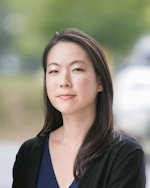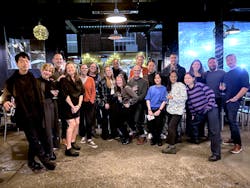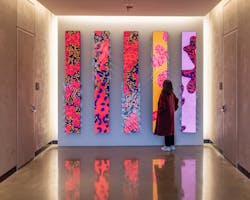LEDs Magazine first learned of design studio SOSO (then called Sosolimited) in 2017 when we reported on a project commissioned for a commercial building at 200 Clarendon St., Boston. The responsive installation, known as "Colorspace," was able to deliver lighting effects from preprogrammed scenarios, as well as turn commands sent by users via text message into undulating patterns and colors. The compelling combination of light guide technology, pendant form factor, and interactivity made this firm one to watch. Since its founding in 2003 at the Massachusetts Institute of Technology, SOSO has opened offices in Boston and San Diego and grown to a staff of 20, led by cofounders John Rothenberg (managing director), Eric Gunther (creative director), and Justin Manor (director of innovation).
Firm mission: Imagine and build a better future through design and technology.
What we are known for: By merging exceptional design with advanced technologies, SOSO unlocks human creative potential and delivers inspiring solutions that embrace the future and improve the world condition.
What people don’t know about us: Before SOSO was an art and design studio, it was an audiovisual performance group. Cofounders Eric, John, and Justin met as students at MIT and, for almost two years, had a monthly residency at the Middlesex Lounge in Cambridge, Mass. They curated music and films around a theme each month and mashed them up live through custom audiovisual software. This culminated in a series of live remixes of the U.S. Presidential Debates in 2008.
First commissioned project: “Patterned by Nature”
What are you currently working on? We’re working with a world-leading technology company to create a street-facing lobby installation and an immersive events space for its Cambridge headquarters. We are using artificial intelligence trained on both poems by New England poets and technical papers by company researchers to generate new expressive text.
We recently opened two installations with Regent Properties in San Diego. “Wish Fountain” is an interactive experience that transforms visitors’ wishes into a colorful, waterlike light show across a bench and wall-mounted screens (not shown). When visitors text an image to “Chameleon Wall,” the result takes on the image's colors and patterns in breathlike strokes and reflective crystals.
Firm culture: SOSO is collaborative at its core, and our team members has a willingness to challenge each other. A source of strength is our multitude of viewpoints, experiences, and expertise. We attract multidisciplinary thinkers who would otherwise be constrained by company silos. For example, we have graphic designers interested in coding, and we have trained architects with a passion for UX. We like having “T-shaped” people who have many interests and one deep specialty.
Industry generalization or perception that should be debunked: Many industry players see light-based art solely as a means to draw attention to a specific area; while this can be the case, it can also be used in a thoughtful, purposeful way to make an impact through wonder, discovery, and emotional connection. For example, in the workplace, installations can go beyond making a lobby look flashy. Our works take charge of the workplace’s energy, reflecting the vibrancy and creativity of the room to create a harmonious flow of energy and creativity between the office and its people.
Top industry concern today: Today’s problems are more complex than ever: climate change, disinformation, emotional isolation, resource scarcity, and social inequity plague the world we live in. Design and computation are two of our most powerful tools to address these issues, but they must be combined for maximum impact. Design focuses technology on human problems, and technology enables design to achieve impact at scale. We work to show people examples of a better future so they can then join us in its realization.
Lighting aggravation (one thing you can’t stand seeing on paper or built): Rainbow chases. Other than during the testing and commissioning process, LED installations should never cycle through all colors of the rainbow. LED lighting designers should be as intentional as any other type of designer with their use of color.
What should the lighting industry talk more about? Sustainability. From material selection to product lifecycle to power consumption, we need to get more serious about our impact on the planet. LEDs, by nature, are lower in power consumption than other forms of illuminations, but at the scale in which they are being installed, such as building façades, they consume a tremendous amount of power. We also need to consider what materials go into this technology and what happens to the hardware after its useful life.
WANDA LAU is editorial director of LEDs Magazine, Architectural SSL, and Smart Buildings Technology. She previously served as executive editor of Architect magazine and worked for a decade in the architecture, engineering, and construction industry.
For up-to-the-minute LED and SSL updates, follow us on Twitter. You’ll find curated content and commentary, as well as information on industry events, webcasts, and surveys on our LinkedIn page and our Facebook page.

Wanda Lau | Editorial director, LEDs Magazine, Architectural SSL, and Smart Buildings Technology
Wanda Lau is an award-winning editor, writer, and podcaster whose work appears in several publications, including Architectural Lighting and Architect, where she was most recently the executive editor. In 2021, she was named one of Folio: and AdMonsters' Top Women in Media, in the DEI Champions category. Along with working a decade in the architecture, engineering, and construction industry, she holds a B.S. in civil engineering from Michigan State University, an S.M. in building technology from MIT, and an M.A. in journalism from Syracuse University.









